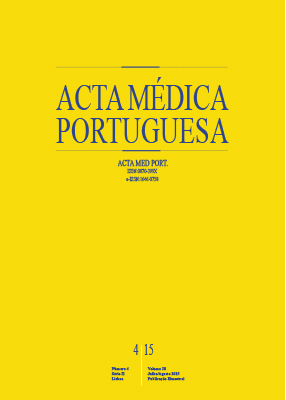Pulmonary Embolism in Ambulatory Oncologic Patients
DOI:
https://doi.org/10.20344/amp.5872Keywords:
Ambulatory Care, Neoplasms, Pulmonary Embolism.Abstract
Introduction: The association between cancer and venous thromboembolism is known, and oncology patients present a risk six to seven times higher than the general population of a thrombotic event. Pulmonary embolism is an important cause of morbidity and mortality in this patients group, presenting an underestimated prevalence.Material and Methods: Retrospective study of all episodes of pulmonary embolism referenced in the last five years. We only selected oncologic outpatients and studied their demographics characteristics, risk factors associated with venous thromboembolism, presence of symptoms at diagnosis, risk stratification of venous thromboembolic events by the Khorana model, probability of mortality at 30 days and overall survival. The study is in accordance with the Helsinki declaration.
Results: From the 186 patients under evaluation, 55.9% were female, with median age of 64 years. The most prevalent cancers were colorectal (24.2%) and lung (17.7%), most of which had metastases (66.1%) or underwent chemotherapy (69.4%). Pulmonary embolism was a radiological finding in 69.4%, whereas no clinical variable was relevant for the presence or absence of symptoms. Mortality at 30 day resulting from pulmonary embolism was 7.5%, and it was found that symptomatic patients had a lower median survival relative to asymptomatic (12 vs. 20 months, p = 0.029). The retrospective application of the Khorana model to those undergoing chemotherapy identified 11% of individuals at high risk.
Discussion: Pulmonary thromboembolism was an imagiological finding in most patients, with no clinical variable able to predict the presence or absence of symptoms. Asymptomatic patients had a higher survival.
Conclusion: In our study pulmonary embolism was apparently asymptomatic in most study patients. These data reinforce the need to evaluate the risk of venous thromboembolism in cancer outpatients and consider conducting antithrombotic prophylaxis.
Downloads
Downloads
Published
How to Cite
Issue
Section
License
All the articles published in the AMP are open access and comply with the requirements of funding agencies or academic institutions. The AMP is governed by the terms of the Creative Commons ‘Attribution – Non-Commercial Use - (CC-BY-NC)’ license, regarding the use by third parties.
It is the author’s responsibility to obtain approval for the reproduction of figures, tables, etc. from other publications.
Upon acceptance of an article for publication, the authors will be asked to complete the ICMJE “Copyright Liability and Copyright Sharing Statement “(http://www.actamedicaportuguesa.com/info/AMP-NormasPublicacao.pdf) and the “Declaration of Potential Conflicts of Interest” (http:// www.icmje.org/conflicts-of-interest). An e-mail will be sent to the corresponding author to acknowledge receipt of the manuscript.
After publication, the authors are authorised to make their articles available in repositories of their institutions of origin, as long as they always mention where they were published and according to the Creative Commons license.









